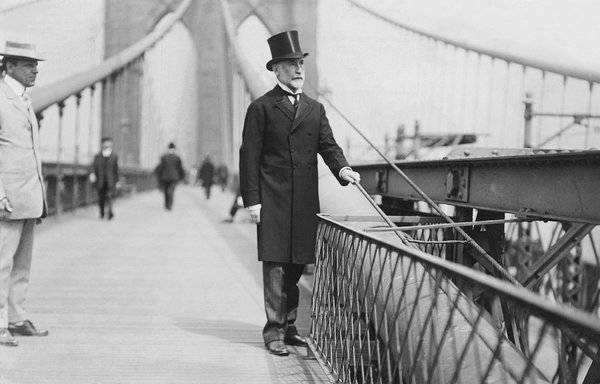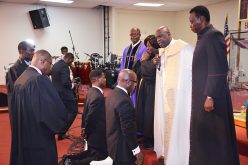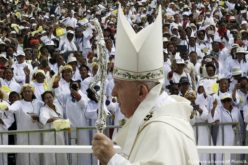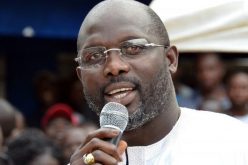
William J. Gaynor walked across the Brooklyn Bridge to his inauguration as mayor of New York City in 1910.
(NEW YORK TIMES) In New York City, no story has gotten more attention in recent years than the ascendancy of Brooklyn. What was once a national punch line became a catch phrase for urban cool — and very costly urban cool, at that.
But on Tuesday night, with Bill de Blasio emerging as the top vote-getter in the Democratic primary and Joseph J. Lhota winning the Republican nomination, Brooklyn moved to center stage politically in a way not seen in decades. Both candidates hail from the borough, and both were propelled by constituencies that populate it.
It was like a variation on an often repeated line: Brooklyn is the new Manhattan. Now, Brooklyn is not only the new kingmaker, but also the borough of kings — or at least of the next mayor.
In their victory speeches, Mr. de Blasio invoked his “beloved Brooklyn” and Mr. Lhota referred to it, too, as his home borough. “Today you can walk through Williamsburg, Fort Greene, Crown Heights — or along the beautiful Brooklyn Bridge Park,” Mr. Lhota said, “and you will see neighborhood after neighborhood transformed into great places to live, work and raise a family.”
Carlo Scissura, the president of the Brooklyn Chamber of Commerce, said, “The winds have shifted across the East River.”
Runoff or not, this means that for the first time in well over a century, the next mayor will be from Brooklyn regardless of who wins the November election. The last time Brooklyn sent one of its own to City Hall was in 1973, when Abraham D. Beame was elected mayor.
But that Brooklyn would be almost unrecognizable today — grittier, poorer, more dangerous. Brownstone Brooklyn has evolved into a gentrified destination for growing numbers of upper-middle-class singles and young couples seeking intimate neighborhoods, artisanal shops and restaurants, and liberal politics.
“There aren’t as many deeply rooted Brooklynites, second, even third generation,” said Pete Hamill, the author and a native of Brooklyn. “So maybe de Blasio is more representative of the new Brooklyn. Whatever that may be!”
That may be, among other things, Mr. de Blasio himself. He was born in Manhattan (across the street from Gracie Mansion), moved with his family to Connecticut and Massachusetts (he is still a Boston Red Sox fan), lived in Manhattan again while he attended college, spent four years in Queens and finally settled 21 years ago in Park Slope, Brooklyn, which he and his wife, who is black, figured would be more receptive to an interracial couple.
Arguably, Brooklyn’s political resurgence has its roots in 1989 when the United States Supreme Court, acting on behalf of Brooklyn plaintiffs, declared the city’s Board of Estimate unconstitutional because the borough presidents of Staten Island and Brooklyn cast the same number of votes on the board even though they represented populations of vastly different sizes.
Also, the city’s black political center of gravity has shifted from Harlem to Brooklyn, which now accounts for more than 4 in 10 black voting-age New Yorkers (compared with a little more than 1 in 10 in Manhattan).
Four years ago, Brooklyn made up 31 percent of the Democratic mayoral primary vote. On Tuesday, the borough constituted 33 percent. Mr. de Blasio won there 46 percent to 27 percent over the citywide runner-up, William C. Thompson Jr., a former city comptroller, who was born and raised in Bedford-Stuyvesant and moved to Harlem in 2008, but still considers himself a Brooklynite.
Brooklyn has its own major-league sports team again, its own branded beer and a clothing line, and has been leading New York in job growth and population in recent years. Since 2010, the number of Brooklyn residents has increased by more than 60,000. The most populous borough since 1930, it is again approaching its 1950 population peak of 2.7 million.
“The sleeping giant is awakening,” said Mr. de Blasio, who celebrated his victory at the Bell House in the Gowanus section.
The Democratic nominee will face Mr. Lhota, who was born in the Bronx but has lived in Brooklyn Heights for 25 years.
“A Brooklyn guy is going to win this election no matter what,” said Marty Markowitz, the borough president.
Exactly what constitutes a Brooklynite is arguable (like everything else in Brooklyn).
Rudolph W. Giuliani was born in East Flatbush, Brooklyn, but was raised on Long Island. Seth Low was born in Brooklyn and served as the mayor of the old City of Brooklyn until 1885, then for a decade as president of Columbia University. When he was elected as the second mayor of Greater New York in 1901, though, after defeating Edward M. Shepard, who lived in Brooklyn, he had lived in Manhattan for a while.
On Jan. 1, 1910, William F. Gaynor, a State Supreme Court justice, walked to his mayoral inauguration across the Brooklyn Bridge from his house on Eighth Avenue in Park Slope. It was the first time he had visited City Hall. Eight years later, John F. Hylan, a former Brooklyn judge, was inaugurated.
The last two full-fledged Brooklynites who were elected to the city’s top office, Mayors William O’Dwyer and Beame, were raised in Brooklyn, but were actually living in Queens — on the very same street in Belle Harbor — when they were sworn in after being elected in 1945 and 1973, respectively.
Mayor O’Dwyer, who had moved there just a few weeks before from Bay Ridge to be with his ailing wife, was born in County Mayo, Ireland. Mayor Beame was born in London and spent his earliest years on the Lower East Side before moving with his family to Brooklyn.
The combined votes for Mr. de Blasio and Mr. Thompson “suggests for many New Yorkers the Manhattan-focused Bloomberg vision of New York as an entrepreneurial city has reached its limits,” said Chris McNickle, the author of “To Be Mayor of New York.”
Mr. de Blasio outpolled Mr. Thompson, who is black, in predominantly black Central Brooklyn, which, Mr. McNickle said, supports “the notion of a continued migration toward post-racial politics.”
Whichever candidate wins in November can only hope to defy history. Mayors from Brooklyn have not been among the luckiest.
Mayor Gaynor, born upstate in Oriskany, was shot in an assassination attempt and died several years later from his wounds. Mayor O’Dwyer left for Mexico — actually, he was named the American ambassador — as corruption investigations edged perilously close. And Mayor Beame, unluckily in the wrong place and the wrong time, was rescued by Gov. Hugh L. Carey from presiding over a municipal bankruptcy.










